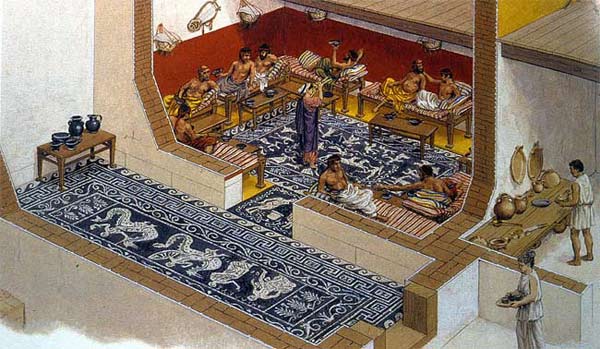In Vino Veritas: Wine Cups Tell History of Athenian Life

Over centuries, the ancient Athenian cocktail parties went full circle, from a practice reserved for the elite to one open to everyone and then, by the fourth century B.C., back to a luxurious display of consumption most could not afford.
The wine cups used during these gatherings, called symposia, reflect this story, according to Kathleen Lynch, a University of Cincinnati professor of classics.
The cups were central to the symposia, where every participant drank the same amount of wine mixed with water, served in rounds, as they reclined on couches or mattresses set in a circle or square.
"In the same way that the coffee mug with 'World's Greatest Golfer' in your kitchen cabinet speaks to your values and your culture, so, too, do the commonly used objects of the past tell us about that past," Lynch said.
As the social context went full circle from elite party to common practice and back again, the appearance of the cups evolved as well, from simple and stemless to a profusion of styles to knockoffs that imitated the appearance of silverwork.
During the Iron Age, from 1,100 to 700 B.C., the symposia were reserved for the elite, and grave markers for the very wealthy were even made to resemble the mixing bowls used to blend wine and water during the symposia. People wanted to be remembered by their ability to throw these events, according to Lynch.
In the latter part of the late Archaic Period, from 525 to 480 B.C., the number of drinking cups increased, indicating the democratization of the cocktail parties, a phenomenon also occurring in the political and social arenas. In fact, these cups for communal drinking outnumbered regular dishes in the typical home.
Get the world’s most fascinating discoveries delivered straight to your inbox.
During the High Classical Period from 480 to 400 B.C., the evolution in design continued, with red-figured cups remaining popular at first, but becoming taller and shallower. As Athenians weathered the Peloponnesian Wars and the plague, they sought escape, and drinking-cup fashions came and went. However, they tended to imitate silverwork: For example, plain, black clay cups with shiny surfaces became more common. Essentially, the common terra cotta cups were "designer knockoffs," according to Lynch.
This knockoff trend continued into the Late Classical Period, from 400 to 323 B.C., and garland and wreathlike designs replaced human forms as decoration. Athenian democracy disappeared, and by the end of this period, the practice of the symposia had returned to the elites. Equality was no longer important in a state that was now a monarchy, according to Lynch. [Tomb Twister: Skeleton May Be Alexander the Great's Father]
She was scheduled to present her work on Jan. 7 (Friday) at the annual meeting of the Archaeological Institute of America in San Antonio, Texas.
- Parthenon Once A Riot of Color
- Gallery: The Seven Ancient Wonders of the World
- Raise Your Glass: 10 Intoxicating Beer Facts
You can follow LiveScience writer Wynne Parry on Twitter @Wynne_Parry.



